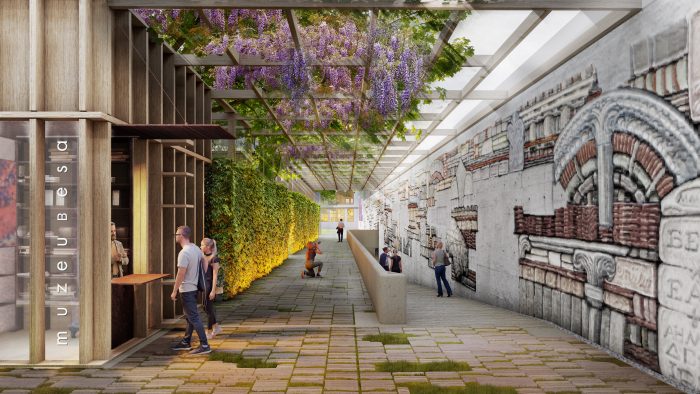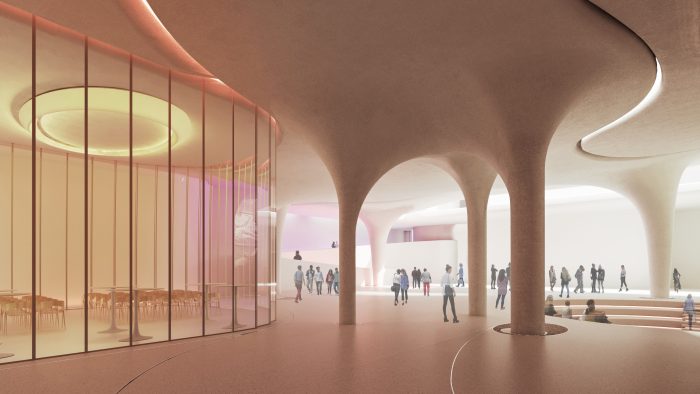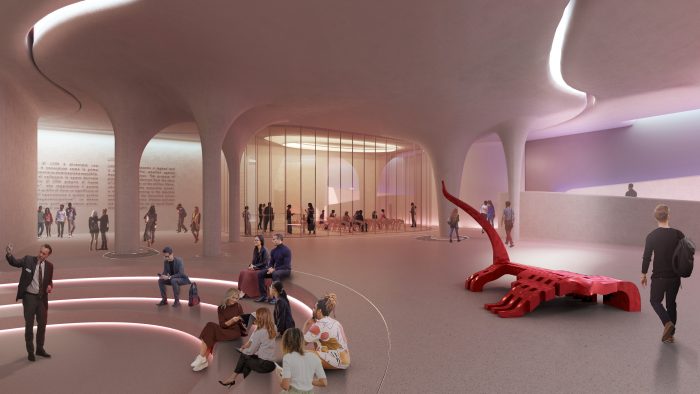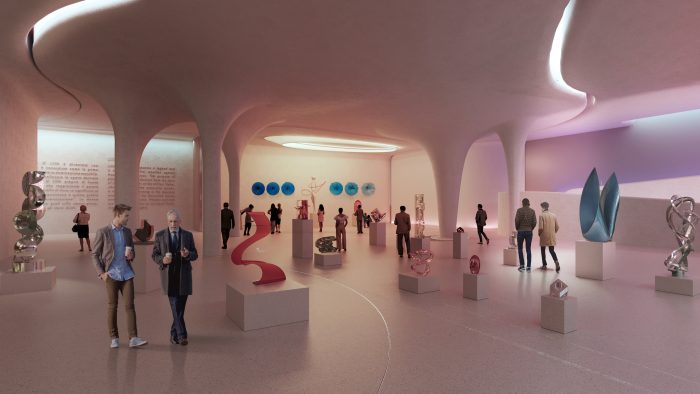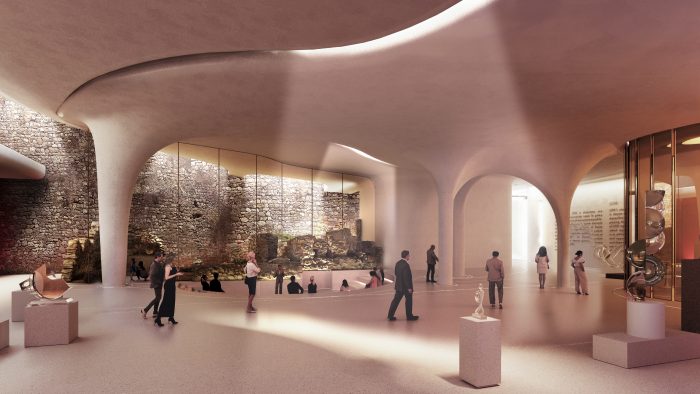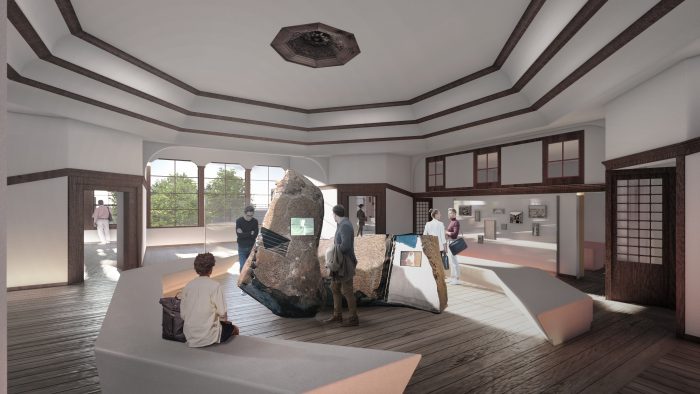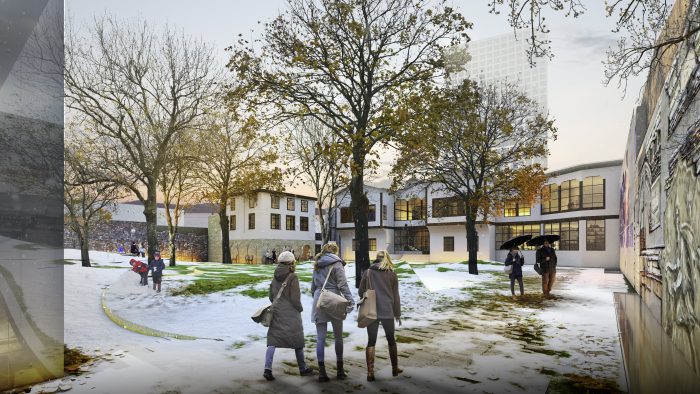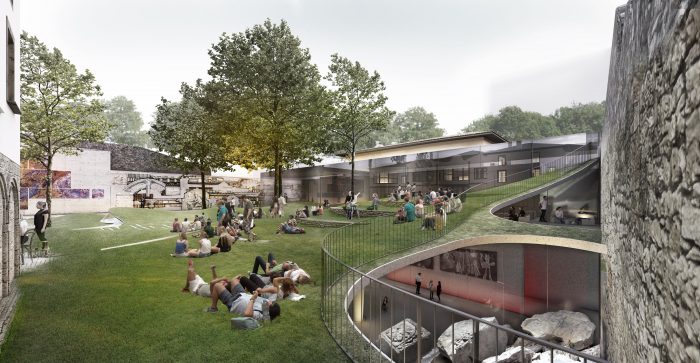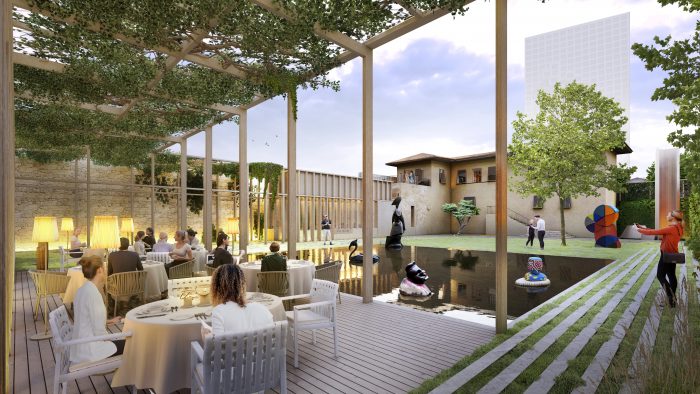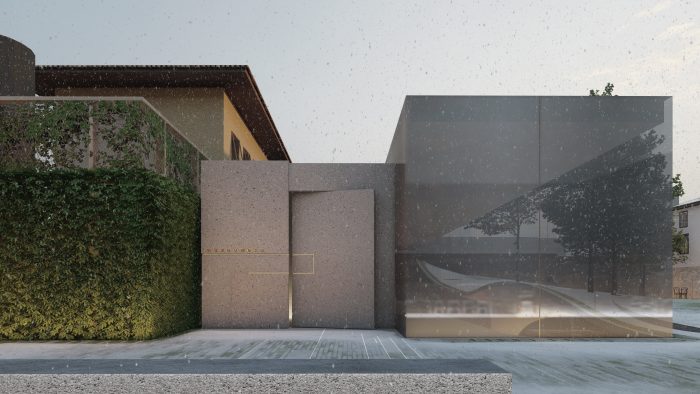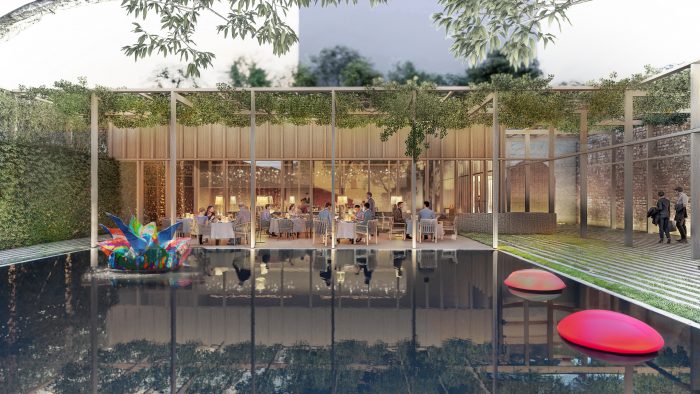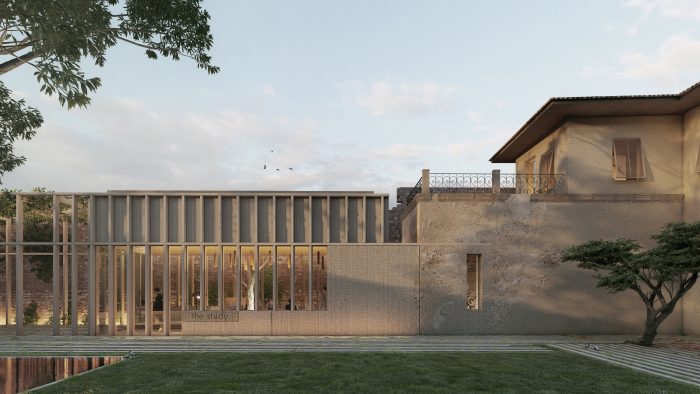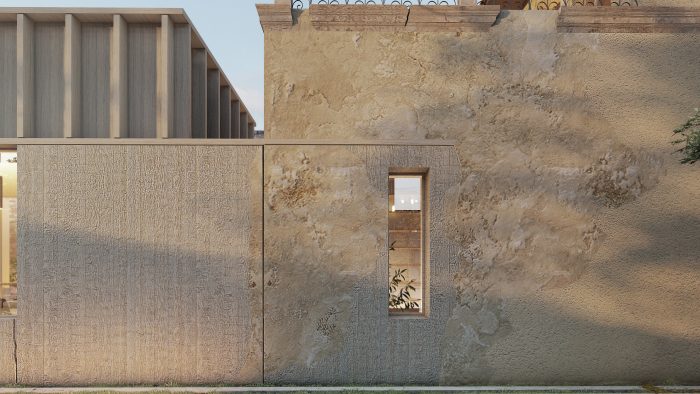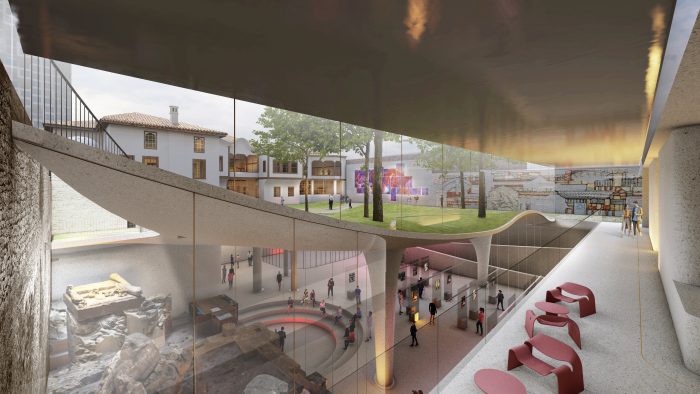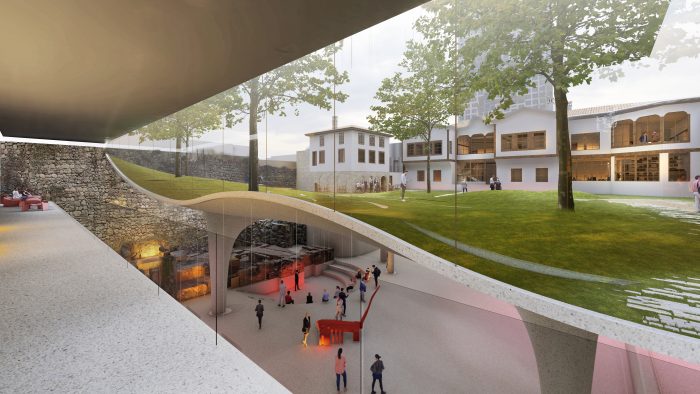Të dhëna mbi projektin
-
Studio
Emre Arolat Architecture
-
Statusi
Concept Idea
-
Viti i ndërtimit
2023
Përshkrimi
Muzeu Besa
by Emre Arolat Architecture
Conceptual framework
Prologue by Emre Arolat
DID YOU JUST SAY “AVANT-GARDE,” PROFESSOR NERITAN? BUT WE INTENDED TO CARRY OUT A CONSERVATION PROJECT…
“Sprawled out in his office after flying back from talks with Manchester City Football Club about creating a network of coaching academies in the Balkans, he cuts an imposing figure in a t-shirt, slacks and gleaming white sneakers. Fluent in an array of languages, he is patently cosmopolitan, despite an upbringing in what was one of the world’s most isolated, vicious and paranoid countries, often described by today’s Albanians as “the North Korea of Europe” before communism collapsed in 1991.
“Italy was our America,” he muses. “TV, Italian football,the pope, music. But even getting TV wasn’t easy.” Here calls draping his room with sheets and carpets so that no one could hear him and his pals playing illicit recordings of the Beatles. He says he remembers his shock and delight when he could read Kafka, Proust and Dostoevsky, listen to Ravel, Debussy and Stravinsky, and see Cézanne, Van Gogh and Picasso.
He is not shy about listing his achievements—or at least post-communist Albania’s. Tirana is unrecognizable from what it was three decades ago: a grim, grey, totalitarian, sub-Soviet, Ruritanian village. Then, the entire country had around 6,000 cars: it was illegal to own one. No with as more than 700,000”
The excerpt above is taken from the article titled “Albania is no longer a bad Balkan joke,” which was published in The Economist last week. A range of illustrative instances from various fields throughout the text vividly portrays the exceptional progress that Albania has made, particularly over the past two decades, the significant changes that have taken place in the social and physical landscape of its capital, Tirana and the background of this remarkable story…
In the first phase of this competition, I conducted a rather personal site analysis and shared a text reflecting my feelings about both Tirana and the area covered by the competition. In that text, I mentioned that we have been carrying out many projects for years in this country, which calls itself “Europe’s last unturned stone. ”Most of these projects are located in coastal regions and topographically challenging areas, where the natural environment remains largely untouched by human intervention and we design contextual projects pre serving the natural structure throughout most sensitivity in those regions.
However, within the same text I also noted that we haven’t yet under taken any projects in Tirana.
Now there seems to be a glimmer of hope…
Second Encounter and Drawing onto the Blankness With Eyes:
In my first writing, I contemplated on the diversity of lives spent here for centuries behind this stone wall. Upon hearing about our progression to the second phase of the competition, I felt compelled to revisit the site. This time, accompanied by Professor Tanyeli, with whom I have collaborated on numerous conservation and restoration projects over the years. I highly appreciate her profound knowledge of the buildings, characteristic of the era in which the Toptani House was built. She has found a few different reference books. Like always, she is eagerly sharing her insights with me along the way. Her passion for research on such buildings is palpable. Given the speculative and conflicting information about the history of the house and its surroundings, taking the correct steps during the restoration process is crucial.
In my last visit, we entered the garden through a wooden arched door and proceeded to walk along an arrow and long space defined by the high walls on both sides stepping on the grass, branches, randomly thrown garbage, and wetness of the freshly fallen rain. It is evident that a significant cleaning effort had taken place in the mean time. Now, we cut through this passage considerably easier. However, I can’t help but feel a strange sense of lack deep inside. It’s as if the untouched, primal feeling from our previous experience has been lost along with the cleaning efforts. The tension created by the audacious overgrown grass obstructing the way has gone, and the passage has turned into a familiar and ordinary pathway. I say to myself that something needs to be done. The entrance to the courtyard of the Suleiman Mosque comes to mind. There is that narrowness that surprises you at first step,as if you feel you are going to be squeezed under the low passage. Then, stepping out into that splendid courtyard right afterwards is an unparalleled experience. Like a well-composed musical piece, the tension between sections unexpectedly raises the excitement within oneself. Yes, something needs to be done. Perhaps returning to its previous neglected state is impossible, but still, something must be done to recreate that tension.
As I repeatedly walk several times throughout the passage, pacing in and out, my mind conjures up a multitude of scenarios passes before my eyes. After some time, my thoughts turn to a simple yet remarkable type of vegetative canopy that was once prevalent in this region and is still in use to this day. It is adorned with clusters of vibrant lilac blossoms in the spring time and I believe it could create the perfect atmosphere and provide an unique initial experience. Moreover, it would offer protection from the sun’s rays to those walking through this relatively lengthy passage. The added bonus of the diverse colors, scents, and textures that will be on display throughout different seasons fills me with an overwhelming sense of excitement… I stand right at the corner of the courtyard, lost in thought for a considerable amount of time. The Toptani House and the Selamlık structure are now directly in front of me. Such a stillness at the city center is truly extraordinary as I mentioned in my previous text. If Tirana’s some high-rises are out of our eye sight, I would think I was in a distant village. Yes, indeed, I can foresee when the Besa Museum is built, this place will turn into a cultural public space, and yes, it is necessary to clean the neighborhood somewhat, making it easy to visit. However, the dose of this cleaning, this sanitation operation is very critical. As I previously stated, this place should not resemble to other ‘pretending to be’ world wide examples. The rustle of the surrounding trees improves even further with the strengthening wind… Tirana is, undoubtedly, has been developing at a rapid pace, and yes, obviously, there are many upcoming projects, some of which pursue outright extravagance. Yet, this is a very special region, and should be approached with concern, knowledge, experience, and compassion. Not only the buildings but also the open spaces surrounding them should be preserved with the same delicacy. While much has been said about the Toptani House and the Selamlık building during this process, it is important not to forget that these structures represent rare surviving examples of their kind, not only in Albania but also in a much broader geography. I feel that their value should be appreciated. No matter what is said, this cannot be merely another new museum project. And again, no matter what is said, this should be a conservation and revitalization initiative, requiring great compassion.
While linger in the courtyard, drawing countless solutions onto blankness with my eyes, Gülsün Tanyeli has already taken hundreds of photographs at the Toptani House. As we ascend the stairs towards the Selamlık building, it becomes apparent that the interior is not in a good state of preservation like the main building. Tanyeli, with a keen eye for detail, meticulously inspects every nook and cranny of the space. The damage on the ceiling of one of the rooms is so extensive that the sky is visible…
Kick-off
Idris says, it truly is a captivating place. He, too, has traveled to Tirana to discover the space and structures first hand. We have collaborated on numerous significant projects for many years, and he will be coordinating the design of this project aswell. We are sharing our observations with our colleagues in the design team at the Istanbul office. Shortly, we will be having our first meeting with a team of professionals from various disciplines and quite diverse countries. We have many participants joining us from various other cities apart from Istanbul and Tirana. Our sustainability consultant is connecting from London, while the team responsible for curatorial work is based in Paris. Our lighting designer is from Milan, and our exhibition design specialist is joining us from Santiago, Chile. With a limited amount of time ahead of us, it is crucial that we coordinate effectively.
As is expected in a group of this nature, there are individuals who are not familiar with one another. Following the introduction part, we present our thoughts to a group of about twenty participants, emphasizing how the main idea of the project has been further solidified throughout this process.We express that this project holds historical, social, cultural, and urban values beyond those of a typical museum project, and that addressing it as a sensitive conservation project within this framework would be appropriate. We then proceed together each participant’s individual input. It is heartening and reassuring to feel that the entire team has internalized and embraced the fundamental back bone of the project.
Within the scope of this framework, we share our thoughts by means of several section sketches on the possibility of creating a new enclosed space-subterranea-beneath the main courtyard that can be made available for public use without disrupting the existing atmosphere. This space should reflect its physical existence derived from the preceding architectural culture, yet strive to attain a neutral identity through abstraction. In doing so, it can help alleviate the pressure on the existing structures and draw attention to itself without being visible. It can even go unnoticed until one enters it. Moreover, the space can accommodate archaeological research without any adverse effects and even allow for the effortless display of findings.
Immediately after, we discuss the green cover that spreads over the subterranea like a soft blanket, as well as the various potential uses of the main court yard.This is not merely an ordinary museum, indeed. Along with its exclusive and abundant open spaces, “muzeubesa” should become one of the city’s fresh and amusing destinations-an attractive meeting point for visitors.
And to conclude…
As previously mentioned, we conducted an intense and highly fruitful mental exercise during this process with our multi disciplinary team encompassing a wide range of fields, including archaeology, exhibition design, landscaping, archival work, restoration and structural design to explore the potential of the site. Ultimately, the concept project took shape through the ideas, site analyses, and research on potentials we had formulated in the initial stages. At this point, I believe that we have gained a deeper understanding of the concept of Besa and have been able to create a coherent, impactful, and sustainable intellectual frame work through it.The common mindset of this working group, which we thoroughly enjoyed collaborating with, provided the foundation for the creation of an engaging narrative.
Eventually, the emerging output can be characterized as either an “avant-garde” approach as described by our esteemed Professor Neritan who was one of the key actors in our working group or a solely compassionate and delicate conversational intervention.
However,I whole heartedly believe that this project will pave the way for the transformation of this highly valuable and unique site at the heart of the city into a distinctive and impressive cultural generator.
Emre Arolat
June 2023
Archeology
In the two online meetings of the team on May 5 and June 1, 2023, I got acquainted with the draft project of the Besa Museum, presented by EAA.
In my long experience in Albanian museology, this project marks an innovation, proposing an original and avant-garde solution in the adaptation for a museum building of an architectural complex of the 18th century. In this sense, it fulfills all the requirements in terms of form, content, creation possibilities and an esthetic qualities for a specific museum, such as "Besa", simultaneously marking an important step in the promotion of new technologies in harmony with architectural traditional values.
My participation as an archaeologist in EAA’s team is defined first by the fact that theToptani Saray, where the "Besa" Museum will be installed, are located within the territory of the Tirana Castle, which is a cultural monument protected by law. Although built in a relatively late phase of the development of fortifications, in the middle of the 17th century, the castle is thought to have been built on an earlier site. Therefore, any intervention in the territory of the castle must be preceded by archaeological survey and excavations. During both meetings I proposed that the survey phase should be carried out through geophysical prospecting, which identifies underground structures without the intervention of excavations.
In the case of excavating an underground museum hall, both phases will be applied, i.e. geophysical prospecting, to determine possible structures, and then excavation. Simple, precursor structures of the Saray, can be discovered at depths of about 1.50m. In case the hall planned for the museum will be deeper, then the structures, if they have architectural interest, can be moved to the same depth. During the excavation, all possible artifacts that may have been deposited in the former courtyard of the Saray, will be collected, to be exhibited in the Museum as evidence of the quality of life developed there in the 18th-19th centuries. The work of the archaeologist, as part of the team, will be the organization of the survey, the supervision of the archaeological excavation, processing of possible artifacts discovered in the excavation and the selection and explanation of those that will be placed in the Museum's showcases.
These conspectus of my work as an archaeologist is the determination of the beginning of the presence of the Jewish element in the territory of Albania. As the earliest archaeological evidence, I have identified the building of the synagogue of Saranda, dated to the 5th century AD. The excavations carried out in the 80s have witnessed two phases in the architecture of the building.
The first, belonging to the synagogue, is evidence of the presence of a Jewish community in the ancient city of Onchesmos, today's Saranda.
Its central hall was decorated with a poly-chrome mosaic,in which the Jewish religious symbol, the menorah, was realized.
In a second period, in the 6th century AD, the synagogue was transformed in to a Paleo-Christian church, undergoing some changes in its shape and decoration. The main change was the covering of the central hall with a second mosaic, with Christian motifs, where the place of the menora has a religious symbol was taken by the Eucharist scene.
The monument is located in the center of the city of Saranda and is the only tourist attraction for the period of Antiquity that is offered to tourists. My proposal is that, without affecting this function of the monument, the separation of the two mosaics should be done, according to a technique implemented in Albania since the 80s (the Apollonia and Mesaplik mosaics displaced in the National Museum).
The Paleo-Christian mosaic will be restored to its place in the hall of the Paleo-Christian basilica of Saranda, while that of the synagogue with the symbol of the menorah will be brought to be placed in the underground hall of the "Besa" Museum, where a copy of the hall will be reconstructed with similar materials. In the same hall of the Museum, the possible artifacts that can be discovered during the excavation of the underground museum environment would be placed, creating an interesting and at the same time significant atmosphere for the visitor.
Appreciating the architect's special care to preserve the identity of the Saray and Selamllik buildings, I have proposed that interventions to create a complete ensemble should also be made to the third building, which is currently outside the Museum's plan. In this context, it could become the library of the Academy of Sciences, an institution that is also located within the territory of the Tirana Castle.
conceptual framework
Prof. Dr. Neritan Ceka
History
Like any museum, this will undoubtedly be an additional value to the cultural and scientific life, especially for the education of the younger generations, not only in the capital but throughout the country.
It will be an interesting stop for foreign visitors, but it will also be meaningful for the locals.
This unique museum, named "BESA," is designed to convey everything related to one of the essential and unique elements of Albanian customary law, BESA. The project envisions the use of various elements, documents, audio-visual images, artifacts, models, digital images, etc. The museum will not be just a space where exhibits are displayed; it will be a multifunctional center. It will serve as a museum and, at the same time, as an educational center, supporting other outreach, commemorative, and temporary exhibition activities.
According to the project, the central part of this historical complex in the heart of our capital will serve as the museum. This will be the most important part of the complex.
Design approach & methodology
CONSERVATION DECISIONS & ADDITIONS
Within the concept boundary of the Besa Competition, Toptani House, Selamlık, and the Neighbor Building with unvaluable additions appeared in time reside in. In light of architectural studies, conducted with painstaking care, Toptani House, Selamlık and the Neighbor Building are decided to be retained, respecting the unique soul of the setting. On the other hand, the less significant additions which bear no intrinsic value to the historical narrative will be removed. This allows for the integration of contemporary elements thought fully designed to meet the museum's evolving needs.
THE NEIGHBOR BUILDING
Initial research has illuminated the historical narrative embedded within the Neighbor Building effectively shaping the architectural settlement approach. Historical data, including the Tirana master plan from 1938 and old photographs from 1923, reflect that the mentioned building was once built in the same period and complements the physical character of the context.
Furthermore, the building holds a unique allure for an adaptive re-use scenario due to its potent ability to recapture its time. The refurbishment project will be undertaken with rigorous precision. The patina formed in time will seamlessly be integrated into the building's new manifestation.
The decision of preserving the building aligns with the architectural design philosophy tailored for muzeubesa that mediates between the past, present, and future, bridging the gap between historical respect and contemporary needs.
a unique series of experiences…
The tunnel
In the realm of architecture, tension is an elemental factor shaping experiences through an intricate dance of proportions and sequences. The Tunnel embodies this statement, presenting itself as a progressively evolving spatial experience.
The untapped potential within the existing corridor-like entrance from Murat Toptani Street to the project site holds the promise of crafting a singular architectural voyage that gently prepares the visitor for an eventual encounter with the distinctive aura of the prairie courtyard, and the Protagonist, Toptani House.
Through a strategic intervention, the Tunnel transforms the existing entry corridor into a tighter, more compact spatial scale, further confining and shielding it. As the visitors step through the arch gate located in the Tirana Castle Wall, they suddenly find themselves in a preparatory realm, one resonating with a sophisticated tension along both the vertical and horizontal axes. This space is consumed through an immersive walking experience, an encounter uniquely shaped by the interplay of architectural and landscape elements. It provides the first hints of being immersed in nature and being apart of it.
This tunnel-like enclosure gracefully dissolves as visitors reach the untouched, expansive courtyard, moving from a sense of narrowness to a sense of openness, from heightened tension to tranquil feeling. This spatial experience manifests an architectural sequence with an air of mystery and allure. It's a balance between order and sensuality, a moment in time that amplifies the courtyard’s distinct ambiance.
Spolia
Spolia is an installation designed by Turkish Artist Ahmet Doğuİpekt that transforms the main entrance of the museum.
*Spolia is a Latin word that means“ spoils.” It refers to an architectural element that has been removed from its original context and reused in a different one. The term “spolia” implies that an element is taken randomly from other monuments and repurposed. On the other hand, the scenes depicted using these elements are typically chosen to compare the existing ruler with the former rulers of the golden ages of the past.
MUSEOLOGY DESIGN PROPOSAL
The museum offers a great diversity of exhibition spaces and cultural exchange. The permanent exhibition rooms are located on the top floor of the historic main building. The small secondary building integrated by a new elevator includes a small space for workshops and activities in the same level. The restored heritage building is considered as a beautiful container and content at the same time.
In the rest of the space in the house, especially on the ground floor, are all the operational and administrative areas. In such a way that the spaces most linked to the exterior are the gift shop and the café, in front of the new courtyard and its playful landscape.
That elevator connects the new underground spaces with both levels of the house. Under the courtyard there are spaces for temporary exhibitions and events, apart from the area that protects an archaeological excavation. In the courtyard itself and on the access ramp from the street,the wall surfaces are used to integrate larger-scale exhibition elements, at the service of the most public activities.
On the other hand, inside the permanent exhibition galleries, the rooms of the house, a more intimate and welcoming space is created:
Tradition and future
Present the idea of BESA as an active, current, and permanent value. This also means, in exhibition terms, creating a perfect balance between the traditional architecture of the house and a rather minimalist, abstract, discreet, and contemporary museographic approach.
Art installations as reference
Bet on an exhibition design that takes the language of art as a reference to synthesize and communicate content, opening the topics to debate and dialogue. Integrating different media and engaging the visitors in a more interactive and immersive experience.
Archive footage and new productions
Consider exhibition devices that allow you to take advantage of available archival materials integrated with others of new production and execution, for better content and flexibility in adjusting resources and budgets.
Collective open call
Consider the exhibition spaces as an open call to participation, so that the visit oral so collaborates in the generation of new content and permanent reflection on the topics covered.
Permanent update and activities
The proposal strategically includes resources that allow the constant renewal and updating of all kinds of content and activities. In this way, the museum will not become obsolete and will maintain its own dynamic that allows it to offer new content in a recurring and simple way, to different audiences.
Vendndodhja
Tirana, Tirana, Albania


